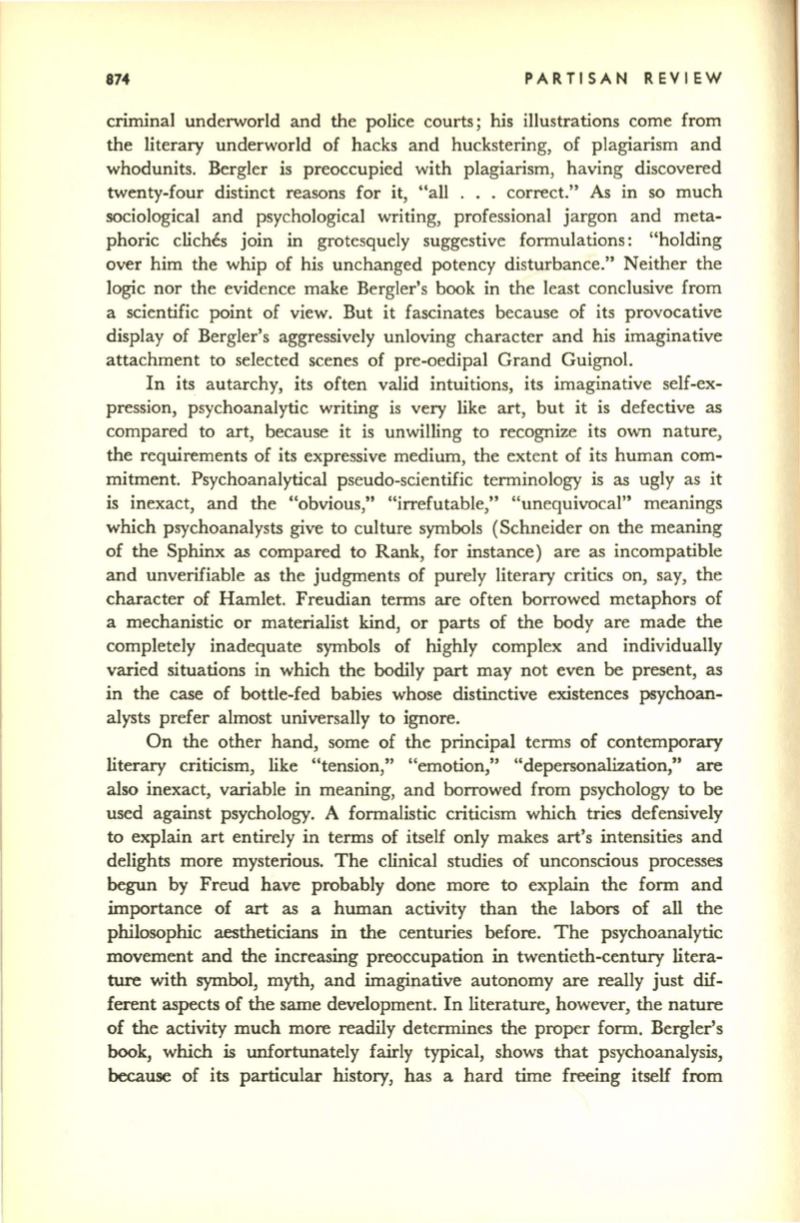
874
PARTISAN REVIEW
criminal underworld and the police courts; his illustrations come from
the literary underworld of hacks and huckstering, of plagiarism and
whodunits. Bergler is preoccupied with plagiarism, having discovered
twenty-four distinct reasons for it, "all . . . correct." As in so much
sociological and psychological writing, professional jargon and meta–
phoric cliches join in grotesquely suggestive formulations: "holding
over him the whip of his unchanged potency disturbance." Neither the
logic nor the evidence make Bergler's book in the least conclusive from
a scientific point of view. But it fascinates because of its provocative
display of Bergler's aggressively unloving character and his imaginative
attachment to selected scenes of pre-oedipal Grand Guignol.
In its autarchy, its often valid intuitions, its imaginative self-ex–
pression, psychoanalytic writing is very like art, but it is defective as
compared to art, because it is unwilling to recognize its own nature,
the requirements of its expressive medium, the extent of its human com–
mitment. Psychoanalytical pseudo-scientific terminology is as ugly as it
is inexact, and the "obvious," "irrefutable," "unequivocal" meanings
which psychoanalysts give to culture symbols (Schneider on the meaning
of the Sphinx as compared to Rank, for instance) are as incompatible
and unverifiable as the judgments of purely literary critics on, say, the
character of Hamlet. Freudian terms are often borrowed metaphors of
a mechanistic or materialist kind, or parts of the body are made the
completely inadequate symbols of highly complex and individually
varied situations in which the bodily part may not even be present, as
in the case of bottle-fed babies whose distinctive existences psychoan–
alysts prefer almost universally to ignore.
On the other hand, some of the principal terms of contemporary
literary criticism, like "tension," "emotion," "depersonalization," are
also inexact, variable in meaning, and borrowed from psychology
to
be
used against psychology. A formalistic criticism which tries defensively
to explain art entirely in terms of itself only makes art's intensities and
delights more mysterious. The clinical studies of unconscious processes
begun by Freud have probably done more to explain the form and
importance of art as a human activity than the labors of all the
philosophic aestheticians
in
the centuries before. The psychoanalytic
movement and the increasing preoccupation
in
twentieth-century litera–
ture with symbol, myth, and imaginative autonomy are really just dif–
ferent aspects of the same development. In literature, however, the nature
of the activity much more readily determines the proper form. Bergler's
book, which is unfortunately fairly typical, shows that psychoanalysis,
because of its particular history, has a hard time freeing itself from


